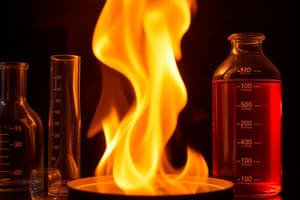Podcast
Questions and Answers
Which of the following factors affect the rate of a chemical reaction? (Select all that apply)
Which of the following factors affect the rate of a chemical reaction? (Select all that apply)
- Temperature of the chemical system (correct)
- Nature of reactants (correct)
- Presence of a catalyst (correct)
- Concentration of the reactants (correct)
How does a 10°C rise in temperature affect the reaction rate?
How does a 10°C rise in temperature affect the reaction rate?
It doubles the reaction rate.
What is the change in kinetic energy during a chemical reaction?
What is the change in kinetic energy during a chemical reaction?
Kinetic energy is converted to internal energy.
What does a catalyst do in a chemical reaction?
What does a catalyst do in a chemical reaction?
How does concentration affect the reaction rate?
How does concentration affect the reaction rate?
What is the relationship between temperature and reaction rate?
What is the relationship between temperature and reaction rate?
What was the catalyst used in the reaction?
What was the catalyst used in the reaction?
What happened when the catalyst MnO2 was added?
What happened when the catalyst MnO2 was added?
What is the equation for the reaction that occurred between MnO2 and H2O2?
What is the equation for the reaction that occurred between MnO2 and H2O2?
What color appears once I3- forms in the Iodic Acid-Sulfurous Acid System?
What color appears once I3- forms in the Iodic Acid-Sulfurous Acid System?
List the acids in order by higher to lower reaction rate.
List the acids in order by higher to lower reaction rate.
List the metals in order by higher to lower reaction rate.
List the metals in order by higher to lower reaction rate.
How many drops are in 1 ml?
How many drops are in 1 ml?
The higher the concentration of reactants, the ______ the reaction.
The higher the concentration of reactants, the ______ the reaction.
The lower the concentration of reactants, the ______ the reaction.
The lower the concentration of reactants, the ______ the reaction.
Flashcards are hidden until you start studying
Study Notes
Key Factors Affecting Reaction Rates
- Nature of reactants, temperature, presence of a catalyst, and concentration significantly influence chemical reaction rates.
- Reaction rates can double with every 10°C increase in temperature, highlighting the impact of thermal energy on molecular collisions.
Kinetic Energy and Reaction Mechanics
- Kinetic energy is converted to internal energy during molecular collisions, enhancing bond-breaking and bond-forming probabilities.
- Increased internal energy facilitates reactions by weakening existing bonds.
Role of Catalysts
- Catalysts accelerate reactions without being consumed, often targeting specific reactions.
- They provide alternative pathways with lower activation energy compared to uncatalyzed reactions.
Reactant Concentration Impact
- Greater concentrations typically lead to faster reaction rates due to increased molecular interactions.
Surface Area of Reactants
- A greater exposed surface area can enhance reaction rates, though this factor was not directly tested in the experiment.
Acid Reaction Rates
- Reaction rates of various acids ranked from highest to lowest: H2SO4, HCl, H3PO4, CH3COOH.
Metal Reaction Rates
- Metals react at differing rates: Mg has the highest, followed by Zn and then Cu.
Temperature and Reaction Rate Relationship
- Higher temperatures consistently result in increased reaction rates, demonstrating a direct relationship.
Catalyst Characteristics
- MnO2 was used as the catalyst in the experiment, leading to the evolution of oxygen gas during reactions.
Catalyst Function
- Catalysts, like MnO2, lower the activation energy necessary for reactions to proceed.
Chemical Equations
- Reaction with MnO2 and H2O2:
- 2H2O2 (aq) -> 2H2O (l) + O2 (g).
- Iodic Acid-Sulfurous Acid System equation:
- 3HIO3(aq) + 8H2SO4 → H+(aq) + I3-(aq) + 8H2SO4(aq) + H2O(l).
Indicator of Iodine Formation
- The reaction involving I3- produces a deep-blue starch-iodine complex, indicating a specific chemical change.
Concentration Effects on Reaction Speed
- Higher concentrations lead to faster reactions, while lower concentrations result in slower reaction times.
Measurement Reference
- Conversion metric: 1 ml equals approximately 20 drops, used for precise liquid measurements.
Studying That Suits You
Use AI to generate personalized quizzes and flashcards to suit your learning preferences.




